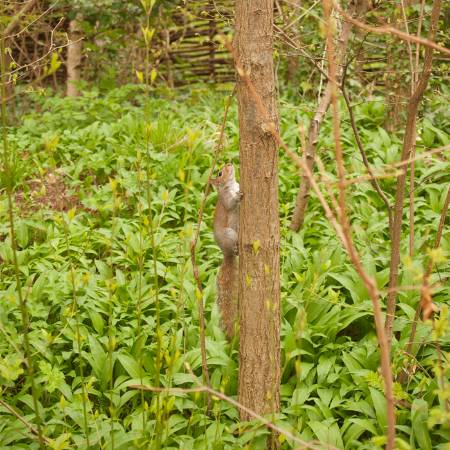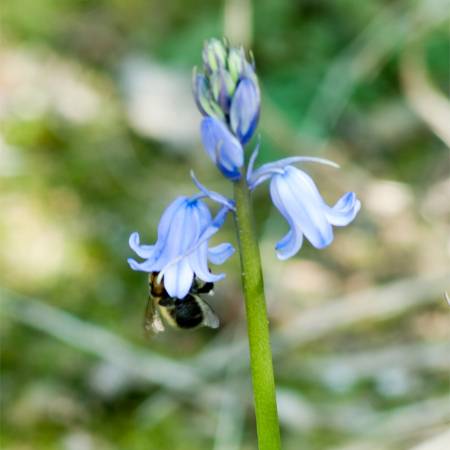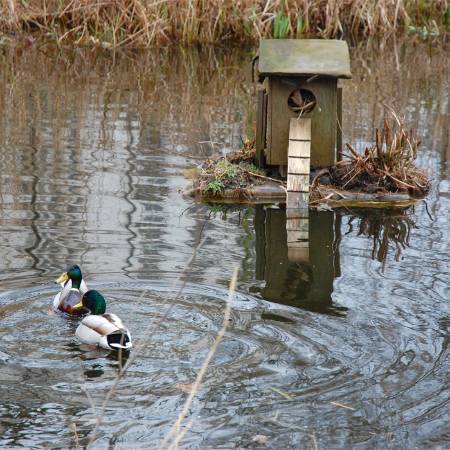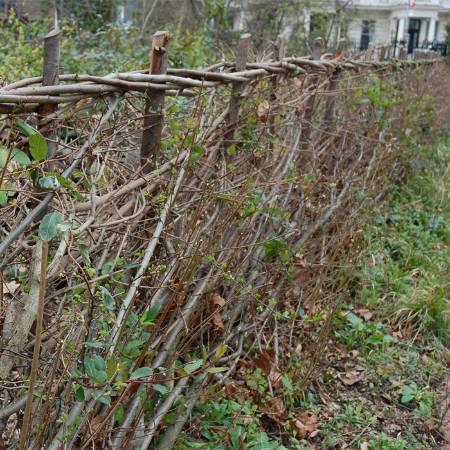Greetings from a garden full of Spring promise! After an absence of several weeks, I recently left winter dormancy behind and have been welcomed by the optimism of spring from the Garden.
The productive work carried out by Larissa, Naomi and our wonderful volunteers these past few weeks is evident from the signs of coppicing, pollarding, pruning and propagating, as well as thinning out some of our most determined umbellifers - cow parsley, hogweed and ground elder.
Coppiced alder (Alnus glutinosa)
© Derek Adams
Seed propagation in preparation for our Spring Wildlife Event on Saturday 5 April
© Sue Snell
And the garden itself has a surprise around every corner. On the ground in the coppiced woodland habitat and beneath the mature lime, the daffodils (Narcissus pseudonarcissus) are in bloom.
The first of our native daffodils was recorded on 25 February nine days earlier than last year
© Jonathan Jackson
There's a fair sprinkling of primroses (Primula vulgaris) in flower, with many more buds yet to open.
Primroses at the edge of woodland - first flower recorded on 18 February; just a couple of days earlier than last year
© Jonathan Jackson
A deeper shade of yellow is offered by the fluffy heads of coltsfoot (Tussilago farfara) which brighten up the hedge banks.
Coltsfoot, a plant typical of waste areas but welcome in our garden
© Derek Adams
Red dead-nettle (Lamium purpureum) along the path provides nectar for early flying insects, and other shades of pink include the occasional red campion (Silene dioica) and herb robert (Geranium robertianum).
Red campion thrives in our Wildlife garden - at least one plant can be seen in flower throughout the year
© Derek Adams
Sweet violet (Viola odorata) is in flower between hedge and pond and dog's mercury (Mercurialis perennis) is increasing its territory beneath silver birch and ash. We'll be contributing our first flower and animal sightings to the Woodland Trust's Nature's Calendar.
Dog's mercury (Mercurialis perennis) - first flower this year was recorded on 13th January
© Jonathan Jackson
But what is most striking is the volume of bird song this week! After crossing the threshold of the Garden the traffic noise of Cromwell Road melts away and a symphony takes over inlcuding the medodic song of blackbirds and robins, rich trills and 'Tshews' from a flock of greenfinches, a medley of calls from blue, great and long-tailed tits, the occasional sound from our moorhen couple, and more.
There are flashes of red and yellow from goldfinches, and blue and yellow as blue tits whirr across our pathways. Territories are being established, courtship is in progress - and in some cases nesting material is already being transported to niches within ivy-clad trees:
A female blackbird was observed building a nest in ivy this week but here the male is feeding up on ivy berries
The supply of rowan berries referred to in recent blogs is finally exhausted!
© Jonathan Jackson
And to nest boxes, and the eaves of our garden shed:
A wren started building here this week, the site was then taken over by a robin and now is currently vacant...
© Larissa Cooper
But not to hedges where there is too little camouflage just yet:
Catkins amongst the bare branches of one of our laid hedges
© Jonathan Jackson
Hazel catkins broke hedge dormancy in early January and now white flowers appear on the bare branches of blackthorn (Prunus spinosa).
Our first blackthorn flowers opened on 18 February
© Jonathan Jackson
This is our earliest flowering native shrub in the Wildlife Garden (and elsewhere). Clouds of white blossom are already visible in hedges in the countryside. One of the many country sayings relating to Blackthorn is that its flowering is said to coincide with a cold spell - but not this week. More blackthorn country sayings and uses can be found on Roy Vickery's website of Plantlore.
Blackthorn is a spikier relative of hawthorn (Crataegus monogyna) - and an excellent hedge companion, quick growing and providing good nest sites amongst a network of spiny branches and thorns. And, in autumn, sloes are food for berry-eating birds.
But this shrub and hedgerow plant is beneficial to many other species: providing nectar for early flying insects such as the tree bumble bee (Bombus hypnorum), first sighted in the garden this year on 15 February; and buff-tailed bumblebee (Bombus terrestris) observed on 6 March.
It's one of the larval food plants for many beautiful moth species including sloe midget (Phyllonorycter spinicolella), tufted button (Acleris cristana), clouded silver (Lomographa temerata) and the brimstone moth (Opisthograptis luteolata), all of which have been recorded here. You can read more about moth recording in the Wildlife Garden, by Lepidopterist Martin Honey in the Spring issue of evolve - the Museum's quarterly magazine.
Brimstone Moth - this particular specimen was caught in our light trap on 6 August and released the following morning
© Florin Feneru
This week also we were shown the concept plans for the redesign of the Museum grounds, some of which included some surprising suggestions for the Wildlife Garden - you can read about this competition at Malcolm Reading Consultants.
Its been a fine Spring week but March is a capricious month and country sayings about the blackthorn weather may yet ring true.
Coltsfoot (again)
© Derek Adams
In the meantime we intend to hold on to our Spring optimism in the Museum's Wildlife Garden and continue to promote and conserve biodiversity here in the heart of London.



.jpg)
.jpg)
.jpg)



